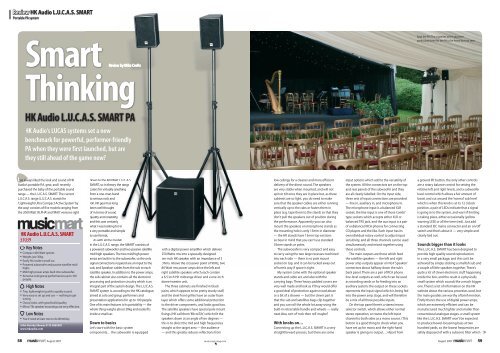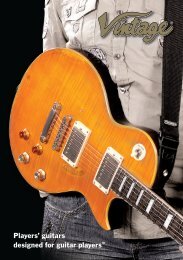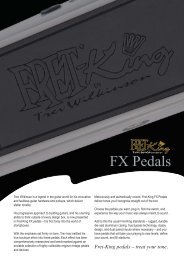Create successful ePaper yourself
Turn your PDF publications into a flip-book with our unique Google optimized e-Paper software.
Review <strong>HK</strong> <strong>Audio</strong> L.U.C.A.S. <strong>SMART</strong><br />
Portable PA system<br />
Smart<br />
Thinking<br />
<strong>HK</strong> <strong>Audio</strong>’s <strong>LUCAS</strong> systems set a new<br />
benchmark benchmark for for powerful, powerful, performer-friendly<br />
performer-friendly<br />
PA when when they were first launched, but are<br />
they they still still ahead of of the game now?<br />
I’ve always liked the look and sound of <strong>HK</strong><br />
<strong>Audio</strong>’s portable P.A. gear, and I recently<br />
purchased the baby of the portable sound<br />
range — the L.U.C.A.S. <strong>SMART</strong>. The current<br />
L.U.C.A.S. range (L.U.C.A.S. stands for<br />
‘Lightweight Ultra Compact Active System’ by<br />
the way) consists of five models ranging from<br />
the 2000 Watt ‘ALPHA’ and ‘MAX’ versions right<br />
music musicmart<br />
<strong>HK</strong> <strong>Audio</strong> L.U.C.A.S. <strong>SMART</strong><br />
£1039<br />
Key Notes<br />
• Compact 400 Watt system.<br />
Weighs just 30kg.<br />
• Easily fits inside a small car.<br />
• Powered subwoofer and passive satellite mid/<br />
highs.<br />
• Mid/high power amps built into subwoofer.<br />
• Aimed at solo/group performances up to 100<br />
people.<br />
High Notes<br />
• Tiny, lightweight rig with a quality sound.<br />
• Very easy to set up and use — nothing to get<br />
wrong.<br />
• Classy looks, with good build quality.<br />
• Micro-Tilt speaker mountings are very effective.<br />
Low Notes<br />
• You’d need at least two to do Wembley.<br />
John Hornby Skewes 0113 2865381<br />
www.hkaudio.com<br />
Review by Mike Crofts Crofts Crofts<br />
<strong>HK</strong> <strong>Audio</strong> L.U.C.A.S. <strong>SMART</strong> PA<br />
down to the 400 Watt L.U.C.A.S.<br />
<strong>SMART</strong>, so in theory the range<br />
caters for virtually anything<br />
from a one-man-band<br />
to serious rock and<br />
roll. <strong>HK</strong> gear has long<br />
been well thought<br />
of in terms of sound<br />
quality and reliability,<br />
and this was certainly<br />
what I was looking for in<br />
a very portable and simple<br />
to use format.<br />
As with all the models<br />
in the L.U.C.A.S. range, the <strong>SMART</strong> consists of<br />
a powered subwoofer and two passive satellite<br />
mid/high speakers. The two mid/high power<br />
amps are built in to the subwoofer, so the only<br />
signal connections requierd are an input to the<br />
sub, and Speakon cables from the sub to each<br />
satellite speaker. In addition to the power amps,<br />
the sub cabinet also contains all the electronic<br />
processing and protection circuitry which is an<br />
integral part of the system design. The L.U.C.A.S.<br />
<strong>SMART</strong> system is, according to the <strong>HK</strong> catalogue,<br />
aimed at solo and group performers and<br />
presentation applications for up to 100 people.<br />
One of its main features is its portability — the<br />
whole thing weighs about 30kg and easily fits<br />
inside a small car.<br />
Down to basics<br />
Let’s start with the basic system<br />
components… the subwoofer is equipped<br />
with a digital power amplifier which delivers<br />
250 Watts rms into a specially-designed<br />
ten-inch <strong>HK</strong> speaker with an impedance of 3<br />
Ohms. Above the crossover point of 90Hz, two<br />
80 Watt rms power amps drive the left and<br />
right satellite speakers which each contain<br />
a 6.5 inch <strong>HK</strong> midrange driver and a one-inch<br />
dome tweeter unit.<br />
The three cabinets are finished in black<br />
paint, which appears to be pretty sturdy stuff,<br />
and the steel front grilles have an outer foam<br />
layer which offers some additional protection<br />
to the driver components, and looks good too.<br />
The satellite speakers have special pole mount<br />
fixings (<strong>HK</strong> call them ‘MicroTilt’) which tilt the<br />
speakers down at an angle of ten degrees —<br />
this is to direct the mid and high frequencies<br />
straight at the target area — the audience<br />
— and this greatly reduces reflections from<br />
58 August 2007 musicmart-mag.com<br />
low ceilings for a cleaner and more efficient<br />
delivery of the direct sound. The speakers<br />
are very stable when mounted, and will not<br />
spin or tilt once they are in place but, as these<br />
cabinets are so light, you do need to make<br />
sure that the speaker cables are either running<br />
vertically up to the cabs or fasten them in<br />
place (e.g. tape them to the stand) so that they<br />
don’t pull the speakers out of position during<br />
the performance. Apparently you can also<br />
mount the speakers on microphone stands as<br />
the mounting hole is only 15mm in diameter<br />
— the <strong>HK</strong> stands have 15mm top sections<br />
so bear in mind that you can’t use standard<br />
35mm stands or poles.<br />
The subwooofer is very compact and easy<br />
to carry using the two large recesses machined<br />
into each side — there is no pole mount<br />
socket on top, and it can be tucked away out<br />
of harm’s way if space is tight.<br />
My system came with the optional speaker<br />
stands and cable set, and also with the<br />
carrying bags. These heavy padded covers are<br />
very well made and look as if they would offer<br />
a good deal of protection against road abuse<br />
or a bit of a shower — but the clever part is<br />
that the sub and satellites bags clip together<br />
and you can roll the whole lot away using the<br />
built-in retractable handle and wheels — really<br />
neat idea, sort of ‘rock then roll’ maybe?<br />
With knobs on…<br />
Connecting up the L.U.C.A.S. <strong>SMART</strong> is a very<br />
straightforward process, but there are some<br />
input options which add to the versatility of<br />
the system. All the connectors are on the top<br />
and rear panels of the subwoofer and they<br />
are all clearly labelled. On the input side,<br />
three sets of input connections are provided<br />
— line in, auxiliary in, and microphone in.<br />
The microphone input is a balanced XLR<br />
socket, the line input is one of those ‘combi’<br />
type sockets which accepts either XLR or<br />
balanced TRS jack, and the aux input is a pair<br />
of unbalanced RCA phonos for connecting<br />
CD players and the like. Each input has its<br />
own idividual rotary control to adjust input<br />
sensitivity, and all three channels can be used<br />
simultaneously and mixed together using<br />
these controls.<br />
The main outputs are those which feed<br />
the satellite speakers — the left and right<br />
power amp outputs appear on NL4 ‘Speakon’<br />
connectors about halfway down the sub’s<br />
back panel. There are a pair of RCA phono<br />
line-level outputs as well, which can be used<br />
as recording sends or for feeding into an<br />
auxiliary system; the output on these sockets<br />
represents the input signal which is being fed<br />
into the power amp stage, and will therefore<br />
be a mix of all three possible inputs.<br />
On the top panel there’s a stereo/mono<br />
selector switch, which allows either normal<br />
stereo operation, or routes the left input<br />
channel to both sides as a mono source. (This<br />
button is a good thing to check when you<br />
have set up for mono and the right-hand<br />
speaker is giving no output…) Apart from<br />
Spot the PA! The organiser at this gig were<br />
particularly keen for the PA to be heard but not seen.<br />
a ground lift button, the only other controls<br />
are a rotary balance control for setting the<br />
relative left and right levels, and a subwoofer<br />
level control which allows a fair amount of<br />
boost and cut around the ‘normal’ sub level<br />
which is when this knob is at its 12 o’clock<br />
position. a pair of LEDs indicate that a signal<br />
is going in to the system, and warn if limiting<br />
is taking place, either occasionally (yellow<br />
warning LED) or all the time (red). Just add<br />
a standard IEC mains connector and an on/off<br />
switch and that’s about it — very simple and<br />
clearly laid out.<br />
Sounds bigger than it looks<br />
The L.U.C.A.S. <strong>SMART</strong> has been designed to<br />
provide high quality sound reproduction<br />
in a very small package, and this can’t be<br />
achieved by simply sticking a smallish sub and<br />
a couple of little speakers together. There’s<br />
quite a lot of clever electronic stuff happening<br />
inside the box, and the result is a physically<br />
small system which sounds like a much bigger<br />
one. There’s a lot of information on the <strong>HK</strong><br />
website about the various processes used, but<br />
the main goodies are worthy of brief mention.<br />
Firstly there’s the use of digital power amps,<br />
which are extremely efficient and can be<br />
manufactured much lighter and smaller than<br />
conventional analogue stages. a small system<br />
like the L.U.C.A.S. <strong>SMART</strong> won’t be expected<br />
to produce bowel-loosening bass at two<br />
hundred yards, so the lowest frequencies are<br />
safely disposed of with a subsonic filter which<br />
music mart August 2007 music mart<br />
59
Review <strong>HK</strong> <strong>Audio</strong> L.U.C.A.S. <strong>SMART</strong><br />
Portable PA system<br />
— by removing unwanted and ‘impossible’<br />
low signals — allows the system to use its<br />
available energy on useful low end material<br />
which provides much improved dynamics, and<br />
protects the driver components at the same<br />
time.<br />
All ‘managed’ active systems employ<br />
some form of limiters, and the <strong>SMART</strong> uses<br />
a multi-band circuit where overall response<br />
can be controlled and optimised to the<br />
speaker characteristics. Finally, there’s some<br />
technology in there called ‘OFR’ which stands<br />
for ‘Optimised Frequency Response’ and this<br />
is what keeps eveything sounding as it should<br />
under a number of different conditions —<br />
various corrections are applied to the signal<br />
to compensate for non-linearities in the<br />
loudspeakers, and the system response is<br />
fine-tuned to maintain the best sound balance<br />
at different volume levels. All of this is aimed<br />
at producing a sound which — at low or high<br />
volume — sounds pleasing to the human ear<br />
and is faithful to the original sound source. So<br />
does it work? You bet it works…<br />
Into action<br />
In its first month this little rig has been out<br />
on three full-blown gigs and a couple of<br />
modest conference room presentations, and<br />
despite it’s diminutive dimensions it really<br />
has performed impeccably. On a five-piece<br />
‘covers’ gig — a reception in a marquee, you<br />
know the sort of thing — it was used for the<br />
three vocalists and a bit of kick drum. The<br />
main problem was actually in convincing<br />
the band that it would be powerful enough,<br />
even though the gig wasn’t intended to be<br />
music mart<br />
a particularly loud affair. All doubts evaporated<br />
after about five minutes (the setting up time)<br />
when the <strong>SMART</strong> system was fired up, and the<br />
lovely clean vocal sound was apparent. The rig<br />
performed beautifully for the whole set, and<br />
seemed particularly well-suited to the female<br />
vocals — I could probably have sold it there<br />
and then and made a few quid, but it had<br />
more work to do the following weekend.<br />
The second live sound challenge was quite<br />
different, and involved providing very high<br />
quality sound reinforcement for an opera<br />
company performing in an open-fronted<br />
marquee to an audience of around one<br />
hundred seated in an adjecent marquee. The<br />
job called for four radio mics for the principals,<br />
three static mics on the chorus, and four mics<br />
to cover parts (mainly strings and piano) of the<br />
fourteen-strong orchestra. As the Oxfordshire<br />
weather control seemed to be stuck on ‘very<br />
wet’, I rigged the <strong>SMART</strong> system under cover<br />
at the front of the audience marquee with the<br />
speakers tucked in right behind the lighting<br />
stands; this went down very well with the<br />
organisers who were insistent — and rightly<br />
so — that the sound system was there to help<br />
the audience hear what was going on, and not<br />
a decibel more… and if possible it should be<br />
completely invisible. The <strong>SMART</strong> system was<br />
absolutely spot-on for this job, and I managed<br />
to achieve a ‘near-invisible’ transition between<br />
the amplified sound and what was coming<br />
directly from the stage. Setting up the<br />
front-of-house took about ten minutes on<br />
this occasion, as I had to use a much longer<br />
cable to connect the right-hand speaker, and<br />
bury it under some gravel and posh carpeting<br />
so that the guests wouldn’t see it. Again, the<br />
<strong>SMART</strong> rig performed with perfect manners<br />
throughout, and earned several positive<br />
comments. One thing that was very noticeable<br />
was the even sound balance between the front<br />
and back of the marquee; the built-in speaker<br />
tilt of ten degrees was just about perfect and<br />
provided lovely even coverage for the whole<br />
audience area.<br />
Packing up was just as easy and I was glad<br />
that I had bought the system complete with<br />
its protective covers — you just zip it up and<br />
wheel it away — brilliant.<br />
The following day we were back at the same<br />
location but this time with grand piano and<br />
vocals only — and again, the <strong>SMART</strong> rig came<br />
through with flying colours.<br />
Not only is it ridiculously easy to transport,<br />
set up and pack away, it sounds really nice too<br />
— just like a big hi-fi — and it looks exactly<br />
right for this kind of upmarket work, where the<br />
last thing you want is anything reminiscent of<br />
rock-n-roll.<br />
Non, je ne regrette rien!<br />
The people at <strong>HK</strong> <strong>Audio</strong> have got his one<br />
absolutely dead right in my opinion — and<br />
that’s as an owner who considers his money<br />
has just been very well spent. It’s a fab little<br />
system; having the <strong>SMART</strong> in the house is a bit<br />
like having a favourite guitar lurking in the<br />
living room — I keep wanting to get it out and<br />
play with it, if you know what I mean! It’s neat,<br />
it sounds smooth and classy but with lots of<br />
dynamics, and it’s just sooo easy to handle<br />
— and in one more gig it’ll be into profit. You<br />
really just can’t say fairer than that.<br />
60 August 2007 musicmart-mag.com

















